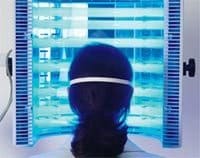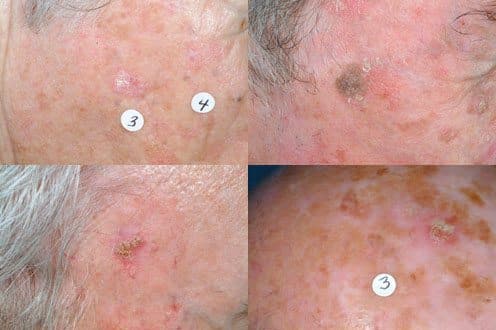

Therapy
Levulan® Kerastick® (aminolevulinic acid HCl) for Topical Solution, 20% (Levulan Kerastick) plus blue light illumination using the BLU-U® Blue Light Photodynamic Therapy Illuminator (Levulan PDT) is indicated for the treatment of minimally to moderately thick actinic keratosis of the face or scalp.
Actinic keratoses (AKs) are rough-textured, dry, scaly patches on the skin that can lead to skin cancer. It is important to treat AKs because there is no way to tell when or which lesions will progress to squamous cell carcinoma (SCC), the second most common form of skin cancer. So, now’s the time to manage your damage!
Up to 58 million Americans have actinic keratosis (AK). While most AKs remain benign, approximately 10 percent develop into SCC within an average of two years. Since there is no way to know ahead of time which ones will become cancerous, it is very important to seek a dermatologist’s care. Frequent skin examinations are the key to early detection and prevention.
WHAT ARE ACTINIC KERATOSES (AKS)?
AKs – often called “sun spots”— are rough-textured, dry, scaly patches on the skin caused by excessive exposure to ultraviolet light (UV) such as sunlight. They occur most often on sun exposed areas such as the face, scalp or ears, and can range in color from skin toned to reddish brown. They can be as small as a pinhead or larger than a quarter.
WHAT DO ACTINIC KERATOSES LOOK LIKE?
Actinic Keratoses generally begin as rough spots of skin that may be easier felt than seen. Common complaints include a lesion that has increased in size or one that is raised, bleeding, poor in healing, discolored, or associated with discomfort such as pain or itching.

While a lesion may initially appear skin colored to pink, red, or brown, lesions on darker skin may be more pigmented. AKs may feel soft, rough, or “gritty,” but in any case, they feel different from the surrounding healthy skin.
Since there are many clinical variants of AKs, it is best to consult a dermatologist if you suspect a lesion.
WHO GETS AKS?
AKs are seen primarily in Caucasians with pale skin living in sunny climates. Areas of the skin with the most sun exposure, such as the head, neck, forearms, and hands account for more than 80 percent of AKs.
Actinic Keratoses develop as the result of years of sun exposure. Because the effect of sun exposure is cumulative, it is your lifetime exposure that increases your risk. Even if you didn’t suntan much, years of just doing simple tasks outside can add up to significant amount of sun exposures. For example:
- Going out to the mailbox
- Playing an outdoor sport
- Walking the dog
Because AKs take a long time to develop, they generally appear after the age of 40. The American Academy of Dermatology estimates that 60 percent of persons apt to get Actinic Keratoses will indeed get at least one AK in their lifetime.
Your risk of developing AKs increases if you have one or more of the risk factors.
WHAT ARE SOME OF THE RISK FACTORS?
- A history of cumulative sun exposure
- Fair skin
- Blond or red hair, in particular if combined with blue, hazel or green eyes
- A tendency to freckle or burn after sun exposure
- A weakened immune system
HOW LEVULAN PDT TREATS AKS?
Levulan PDT, a 2-part treatment, is unique because it uses a light activated drug therapy to destroy AKs. How does it work? Levulan Kerastick Topical Solution is applied to the AK. The solution is then absorbed by the AK cells where it is converted to a chemical that makes the cells extremely sensitive to light. When the AK cells are exposed to the BLU-U Blue Light Illuminator, a reaction occurs which destroys the AK cells.
The 2-part treatment offers the following conveniences:
- No prescription to fill
- No daily medication to remember
- Treatment is administered by a qualified healthcare professional
Levulan PDT can also fit your lifestyle:
- The 2-part, 2 office visit treatment is completed in less than 24 hours
- Low downtime*
- High ratings for cosmetic response
- No scarring reported to date
*Patients treated with Levulan PDT should avoid exposure of the photosensitized lesions to sunlight or prolonged or intense light for at least 40 hours.
SCHEDULE YOUR APPOINTMENT TODAY!
For more information contact us today or click here to schedule an appointment. Our practice has locations in Burbank, West Hills, Pasadena, Northridge, Santa Clarita, and Glendale.
